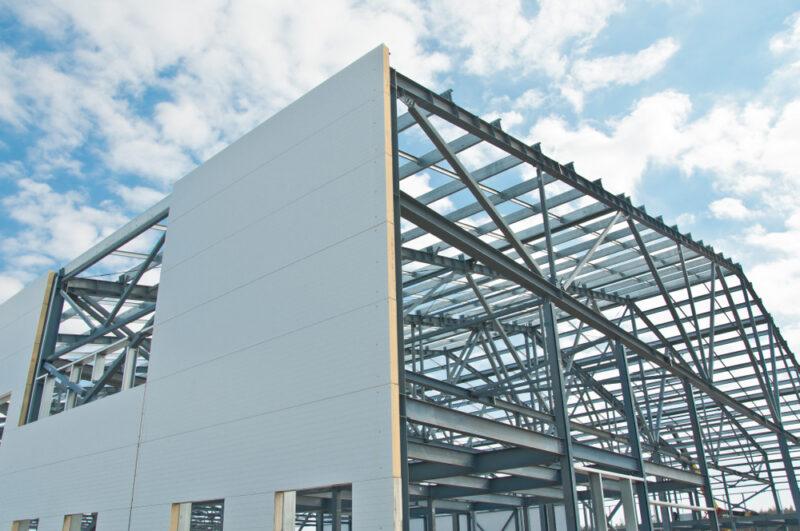Blog Steel Commander Corp
Sustainable Steel Construction: Strategies for Reducing Environmental Impact

Global pollution receives significant contributions from the construction industry. However, builders can now employ modern technology to decrease their negative environmental effects. This environmental movement adopts Sustainable Steel Construction as one main component. The material delivers maximum strength through durability and complete recyclability. Moreover, the use of steel allows builders to construct sustainable buildings that maintain their quality for numerous decades.
Additionally, steel remains as strong after endless reuse because its recyclability extends throughout multiple cycles without any strength degradation. Furthermore, steel stands out because it undergoes repeated melting and reshaping processes which makes it an optimal selection for sustainable building practices. Commercial Steel buildings maintain minimal tacky demands and repair needs that create additional reductions in their environmental impact. Correct insulation combined with energy-efficient architectural elements enables steel buildings to decrease their operational heating and cooling expenses.
The article investigates multiple approaches for enhancing sustainable steel construction projects. Besides, the article examines material preference techniques alongside energy conservation methods and strategies for waste management. So, let’s dive in!
The Importance of Sustainable Steel Construction
The building techniques of the past require large amounts of energy together with significant material consumption. Environmental contamination along with wasted resources occurs as a result. However, steel is 100% recyclable thus, it offers a greener alternative. The world recycles steel at an exceptional rate as one of its most recycled industrial materials. Sustainably managed steel provides a better environmental performance than both forests destroyed by wood and concrete’s heavy carbon emissions.
Steel manufacturing operations have introduced environment-friendly practices throughout the years. Current industrial innovations enable steel manufacturing that requires lower amounts of both emissions and energy. Moreover, the application of sophisticated recycling methods enables steel recovery from waste products which subsequently prevents the need for fresh materials while keeping steel out of landfills. When manufacturers improve their energy consumption during steel production they will reduce the pollution levels in industries.
Besides, a builder who implements Sustainable Steel Construction benefits through:
- Lower carbon emissions
- Reduce waste
- Improve energy efficiency
- Create long-lasting structures
- Decrease reliance on non-renewable materials
- Improve sustainability in urban development
Now, let’s look at some key strategies to achieve this.
1. Using Recycled Steel
The use of recycled steel creates major impacts in construction projects. The implementation of steel recycling creates two major benefits because it minimizes raw material requirements and decreases power consumption. Production of steel through recycled materials requires 75% less energy than the process of making steel from iron ore.
In addition, responsible steel suppliers should be the source for builders. The sustainable steel products offered by Steel Commander Corp. meet high-quality steel criteria. The combination of cheaper steel production costs together with environmental advantages emerges from adopting recycled steel.
2. Improving Energy Efficiency in Steel Production
The manufacturing process of steel depends heavily on substantial amounts of energy. The current development of technological solutions works to decrease steel manufacturing’s environmental impact. So, some key solutions include:
Electric Arc Furnaces (EAF): These use electricity instead of coal, cutting emissions.
Waste Heat Recovery: Initiatives within factories enable them to recycle their heat emissions for energy savings.
Renewable Energy: The combination of solar and wind energy systems enables steel plants to transition to renewable power operations.
The choice to acquire steel from sustainable producers enables construction companies to back environmental sustainability.
3. Designing for Longevity and Adaptability
A sustainable building needs to retain its value over numerous years. Existence of steel structures provides both strength and natural disaster resistance. Furthermore, such materials make it possible to perform straightforward modifications with ease.
In addition, a steel-framed office building allows expansion through wall-free expansion methods. Reducing demolition waste and saving materials become possible through this approach. Sustainable Steel Construction involves future-oriented strategic planning.
4. Reducing Construction Waste
Waste production at construction sites reaches enormous levels. Steel components are easily processed off-site through cutting and shaping operations. The reduction in leftover materials and waste sent to landfills becomes possible through this method.
Different measures aimed at waste reduction consist of:
- Pre-made steel components achieve perfect fits which eliminates extra material.
- Excess steel materials can be turned into useful steel by the process of melting it down for recycling.
- The avoidance of excessive materials happens through planning that promotes efficiency.
The implementation of these measures leads to additional environmental friendliness in Sustainable Steel Construction.
5. Using Green Coatings and Finishes
The chemical composition of traditional steel coatings includes dangerous substances. Luckily, there are eco-friendly alternatives.
- Water-based paints produce fewer toxins.
- Powder coatings have no harmful solvents.
- Galvanized steel maintains its lifespan longer than other materials therefore it reduces the need for ongoing maintenance.
6. Supporting Sustainable Steel Suppliers
The world contains steel materials with varying qualities. Multiple steel producers generate dissimilar amounts of pollution in their manufacturing operations. Builders need to pick organizations which practice responsible business operations.
Besides, Steel Commander Corp. exemplifies an excellent company in this field. The company delivers long-lasting steel products that operate sustainably. Joining forces with ethical suppliers provides you with excellent materials which produce lower environmental impact.
Conclusion
The building industry is transitioning toward Sustainable Steel Construction as its main construction approach. The planet receives direct protection through the combination of steel recycling with energy and waste reduction practices.
Moreover, the long-term financial advantages of sustainable steel construction emerge from its ability to deliver economic benefits after environmental advantages. The material longevity decreases the need for maintenance projects and structural replacements. When constructed with steel the buildings undergo specific design methods that lead to reduced energy costs for electricity and heating requirements. Furthermore, the price reductions associated with sustainable steel create a strong financial case for purchasing it by companies and homeowners.
Additionally, the entire global industry and all governments currently work actively to find sustainable solutions. Builders and architects together with property owners who select sustainable steel make progress toward sustainability goals. The collaboration between us will result in a sustainable green future.
Are you ready to build greener? Explore sustainable steel solutions by visiting Steel Commander Corp.




















